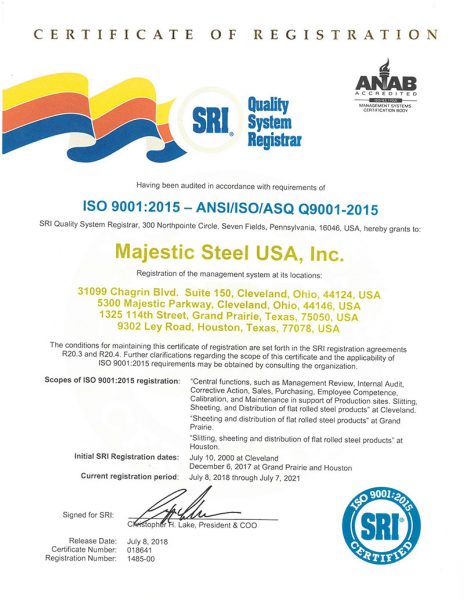Market Report Recap I March 10th 2021
Special guest Alex Ulanov, the Co-Lead of the Metals Practice at McKinsey, joined Majestic Steel’s President & CEO Todd Leebow, and Market Analysts, Chris Billman and Scott Peskowitz to address the current market conditions. Lead times remain extended, and supply continues to tighten while deferred demand is on the rise. Read on for a recap of yesterday’s report and feel free to contact your Majestic representative if you have any questions.
SUPPLY
– At this time, we are seeing no signs of prices pulling back through Q3 given current domestic production, inventory levels, import volumes, and demand.
– Both supply chain disruptions and increased demand continue to create limited steel availability in the market.
– While mills have plans to add additional new capacity, both planned and unplanned outages will offset the additional tons entering the market.
– New mill leadership is making decisions based upon value versus volume. While this transformation can take time, they are showing more signs of discipline than in the past.
– The domestic market needs imports when supply is this tight. However, global supply chains are just as, if not more, challenged than our market. Import lead times are extended into late Q2 with volumes that won’t offset the current tightness.
– The scrap market is getting tighter as demand increases and supply is restricted:
– Over 70% of steel in the U.S. today is produced through an EAF (Electric Arc Furnace) which mainly utilizes prime scrap for steel making. With new EAF capacity coming online, this is stressing the already tight scrap market.
– As EAF mills grow throughout the world, scrap demand will grow as well. Alternatives such as DRI (Direct Reduced Iron) are being used today at mills like Nucor who have made these investments in prior years.
TRADE
– Section 232 tariffs aren’t expected to change in the near term, but we could see it evolve with the current administration. Other tariffs remain intact beyond 232 keeping low priced imports out of the domestic market.
– One way to combat a domestic carbon tax is to tax high carbon product imports. This tariff would put pressure on countries who have not adopted low carbon producing capabilities.
– While a carbon tax is seen as a negative, the U.S. is a leader in sustainability when it comes to steel making. Mills have made significant investments over the recent years to reduce the impact on the environment while making steel more efficiently.
– Given the current supply constraints there’s a need for fair trade imports that comply with the current policy enforced.
– On the policy front, we need a legislative and trade approach that puts American businesses first; supporting domestic production while recognizing the global dynamics we face today.
FURTHER CONSOLIDATION
– After a large amount of steel producer consolidation, the next wave will most likely be in scrap and service centers.
– Consolidation will be pushed by factors like restricted supply, unsecured succession planning, and attrition. The benefit to customers will be more visibility, and ideally reliability, in what is currently a fragmented market.
– Companies will always look to sell in strong markets. Because of this, we anticipate an increase in companies taking advantage of their position further accelerating consolidation as long as both sides can generate value.
– Those that generalize or commoditize are going to struggle in this environment. Steel is a highly engineered product with scarcity in today’s market and you cannot treat it like a commodity.
DIGITAL INNOVATION
– Digitization allows for scale and growth – but we need to invest in digital talent and technologies with patience. It does not become a core competency overnight.
– No industry, including ours, is immune to digitization. Those who ignore the shift will be left behind.
– We believe digital is an opportunity for an evolution towards a more efficient supply chain because it enhances needed visibility into the market.
– Digital solutions are not a threat to relationships. We already rely on them through email and text, which are highly fragmented and inefficient for workflow processes and transactions. These solutions will only make relationships and businesses stronger.
– Understanding your customer’s needs and making things easy for them is critical for any successful business. Digital tools allow our industry to better understand customers and respond with real-time data and accuracy.
– One platform in the market is Felux, which helps companies buy and sell steel more seamlessly whether you have existing relationships with suppliers and customers or are looking for new opportunities.
SUSTAINABILITY
– We see the renewable sector continuing to grow and driving demand for steel.
– Steel has been leading the way in sustainability for decades with investments in modern steel making through a recycling process.
– Oil is not going away. Seeing the Texas electrical grid going down proves there is a need for both oil and gas while renewable energy grows.
– Carbon footprints should be viewed in global totality.
– China’s environmental responsibility shouldn’t be viewed differently than ours when they produce 900+ million tons to the U.S.’ roughly 100 million tons today.
WHAT TO WATCH OUT FOR
While demand is strong, it’s 15% below this time last year. Deferred demand is going to come to a head with more businesses reopening and a third stimulus package. Today’s market environment requires daily attention to understand what’s impacting supply and demand and driving prices to historic levels.
A link to the full webinar video recording can be found here. We had a lot of great questions come through and we’ll be following up with those answers shortly. As always, we welcome feedback to ensure your experience with us is Majestic and look forward to seeing you at our next webinar. If you’re interested in receiving additional real-time market information, we encourage you to subscribe to the CORE Report or reach out to your sales contact.
